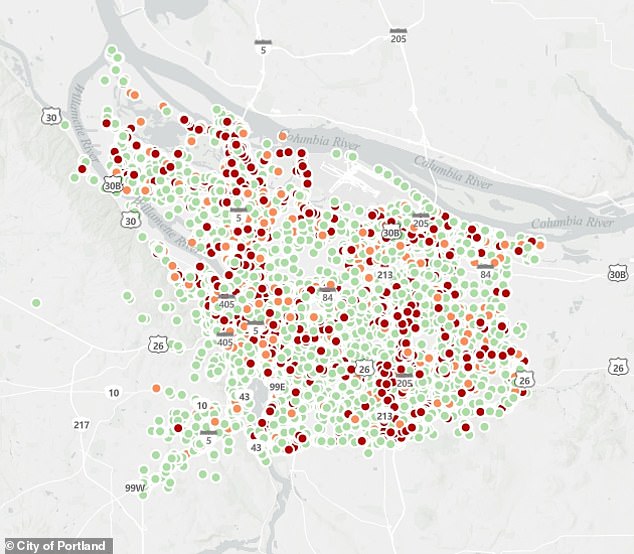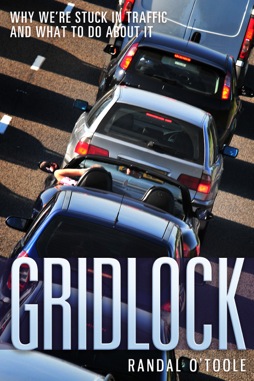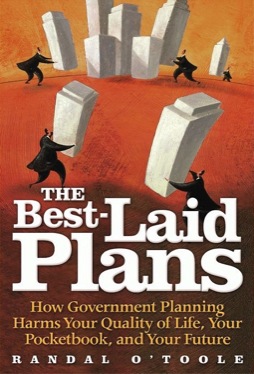Oregon housing prices are “soaring.” Homelessness is increasing. Not having anything else to do, homeless people turn to drugs, aided by city and county programs giving them free syringes and other paraphernalia.
 This map shows homeless camps identified by the city of Portland. Colors indicate the risk of crime each camp supposedly poses to nearby neighborhoods.
This map shows homeless camps identified by the city of Portland. Colors indicate the risk of crime each camp supposedly poses to nearby neighborhoods.
This leads to conflicts as people who actually have homes find their neighborhoods invaded by homeless people and their tents (given to them by the county government), drug dealers, and associated problems. This has Progressives looking around for someone to blame for all this other than themselves.
The latest scapegoat is the Oregon bottle bill. Passed in 1971 to help control litter, the bottle bill requires a 10 cent deposit on all beverage cans or bottles. As a result, up to 80 percent of Oregon cans and bottles are returned for recycling, as opposed to around a third in states with no bottle bills. Environmentalists and libertarians both support the bottle bill as an incentive-based solution to the problem of littering and pollution.
Yet now the bottle bill is come under attack for “dragging down Portland” because homeless people pick up discarded bottles and take them to redemption centers, which then become centers for drug trafficking. This has led the legislature to amend the bottle bill to make it more difficult to return bottles for a refund.
Meanwhile, another “solution” to Portland’s housing crisis, inclusionary zoning, has been proven to be a failure. Portland’s inclusionary zoning law requires builders to set aside a fourth of the units they build for below-market housing to low-income renters or buyers. The result? Far fewer homes were built as builders saw this as an unbearable tax on production. This should be no surprise, as California economists proved more than 20 years ago that inclusionary zoning makes housing more expensive.
Portland has become a theater of the absurd. Instead of blaming the bottle bill, the region should greatly expand, or better yet abolish, its urban-growth boundary that has made land too expensive for housing. Instead of enabling homelessness and addiction by giving people tents and syringes, the region should find them jobs and reintegrate them into society. Of course, none of this is likely to happen, and Portland and Oregon will continue to lurch from scapegoat to scapegoat without solving any of its problems.








Free syringe exchanges may be grim but they’re far better alternative to shared needles. By the 2000s shortage, smoke able drugs were supposed wean off needle and iv drugs but rise fentanyl, needle use exploded again….sad state of affairs
Stop blaming UGBs for homelessness! This issues has been studied very well. Homelessness is exploding since the 1970s, because of deinstitutionalization and welfare cuts and the decline of public housing programs. None of this has anything to do with UGBs. UGBs protect the natural landscape and reduce sprawl, which are good things.
The Political Left fought LONG AND HARD against forced institutionalization of mentally ill. Kosher Lobby and their ACLU puppets defered that taking people against their will pumping them full of drugs and sterilization …so much so they forced Reagan to defund and empty out asylum and hospitals.
Whole episodes of Law and order from 90s onward depicted our institutional failures of mentally ill thanks to widescale implementing of opening our mental facilities.
Empyting the asylums was a libertarian policy.
It started in the 50’s when Thorazine was approved to treat mental illnesses like schizophrenia and bipolar disorder. Its nominal ability to control psychosis—combined with a heavy marketing campaign that made it one of the first blockbuster drugs—helped promote the notion that mental illness could be cured with medication. Specialty inpatient psychiatric hospitals would no longer be needed because patients would no longer need the kind of intensive care they promised to provide.
When Kennedy signed the 1973 Community Health Centers Construction Act (the last bill Kennedy would sign.) he said, “custodial mental institutions” would be replaced by community mental-health centers, thus allowing patients to live—and get psychiatric care—in their communities.
Finally, in 1965 the creation of Medicaid accelerated the shift from inpatient to outpatient care: One key part of the Medicaid legislation stipulated that the federal government would not pay for inpatient care in psychiatric hospitals.
When Kennedy signed the 1963
Community Health Centers Construction Act…
UGB don’t protect shit except property values. The idea of UGBs pushing down prices is a red herring. New houses built on the edge of them are invariably massive suburban detached houses with boatloads of bedrooms and multicar garages. Low income people could never afford them. Under the “filtering” theory, rich people would move to them, therefore freeing up housing for low income people. This doesn’t happen, because rich people have the money to live where they choose. And if they choose to live in city center…. thats why townhouses in city now priced like mansions. Oregon instituted their UGB policies in the 70s and 80s when a small lot was considered a quarter acre. Now there’s homes built on less land than the street in front at 1/10th Acre. Oregon could open 50,000 acres a year (0.08% states land area) build 300,000 homes on 1/8th Acre lots. 50% parcel could still be woods/parkland, small farm. One out of every 6 lots coild be multi family dwelling and house additional 40,000 families/people.
Urban growth boundaries are economic junk science
Again, the point of UGBs is to protect the natural landscape and reduce sprawl. Nature is not an end in itself. Nature serves humans, which is why humans should treat nature well; otherwise, humans will not thrive. It is therefore important to preserve natural landscapes where humans live, and not just far outside of metropolises. Nature serves as a place for local recreation and is therefore fundamentally important for human health.
Even lefty authors in California recognize containment accomplishes nothing but increasing unaffordability. Your view on “sprawl” and even what constitutes sprawl is nothing more than a personal opinion driven by your fetish for density. Here’s what others say about containment based on recent studies:
https://www.newgeography.com/content/008551-the-death-family-home-killing-american-middle-class
UGBs are a fail unless the objective was to make housing unaffordable.
UGBs are pretty succesful in reducing sprawl. Since its inception in 1979, Portland’s population has grown significantly (60%), while the urban growth boundary has expanded by a much smaller proportion (around 14%). This has largely succeeded in preserving surrounding farmland and forests from haphazard urban development. y limiting outward expansion, the UGB has encouraged denser development within the existing urban footprint. This has led to significant infill development and redevelopment in central Portland and close-in locations, maximizing the use of existing infrastructure and land. Studies show that a high percentage of growth (e.g., 94% of growth since 1979) has occurred within the original UGB. The scarcity of developable land inside the UGB has generally led to increased land values and a more efficient use of land within the boundary. By concentrating development, the UGB supports the effectiveness of public transit systems, making them more viable and accessible for a larger population. It also supports walkability and the increased cycling. The UGB is credited with contributing to Portland’s reputation as a highly livable, green city by preserving open spaces and promoting public areas within the urban fabric. The UGB’s success is attributed to widespread political support for limiting growth. It’s also a flexible tool that is regularly reviewed and adjusted (expanded about three dozen times since its inception, mostly in small increments) to accommodate projected population and employment growth for the next 20 years.
In other words, a UGB only operates to increase the cost of land and therefore decrease the affordability of housing. You readily admit the boundary is expanded – so none of that land added is “preserved”. Also the land you are referring to is not owned by the state or city – it is privately owned.
It’s a bit arrogant to apply your vision to other people’s property without compensating them. Th property outside the artificial boundary is rendered near valueless while the owners are prohibited from developing it.
UGBs are a fail. Nothing you have promoted is a “positive” except in your mind. It’s a wealth transfer across the boundary – a taking. People end up pursuing housing in another area to get the kind of housing they want and they commute – thus leapfrogging the barriers the denserati tried to construct.
The denserati actually create what they despise because people do not like density. When you try to force feed density, it causes people to move outward to get what they want: better and larger housing, better costs, more room, etc. It’s not rocket science to see the denserati are selling snake oil.
The UGB in Portland and elsewhere is very successful. The UGB saved a lot of land from development that without UGB would have been developed into lots for single family housing. The expansion of the boundary doesn’t refute this. On the contrary, as is evident by the fact, that the boundary grew less than the population. Which means Portland got denser and land was saved from development. It worked. If leapfrogging would have entirely countered the UGB, then the population would not have grown faster than the UGB. They simply would have moved elsewhere. The population of Portland would not have grown faster than the UGB, but this didn’t happen. The population grew faster than the UGB, which is evident that land was saved from development and leapfrogging hasn’t prevented the positive effects of the UGB.
There is no density in the US, which has the quality of life of a Groningen or Utrecht. Density in the US is non-existent. 20 million Americans tourists visited Europe in 2023. Clearly they like density, but have given up on trying it in the US, because they don’t understand what is needed to implement it. For example, realizing that their cars and SFHs are part of the problem.